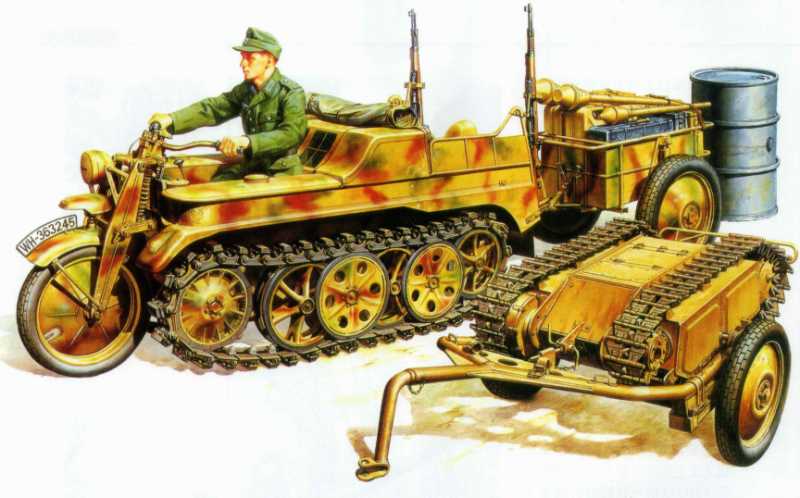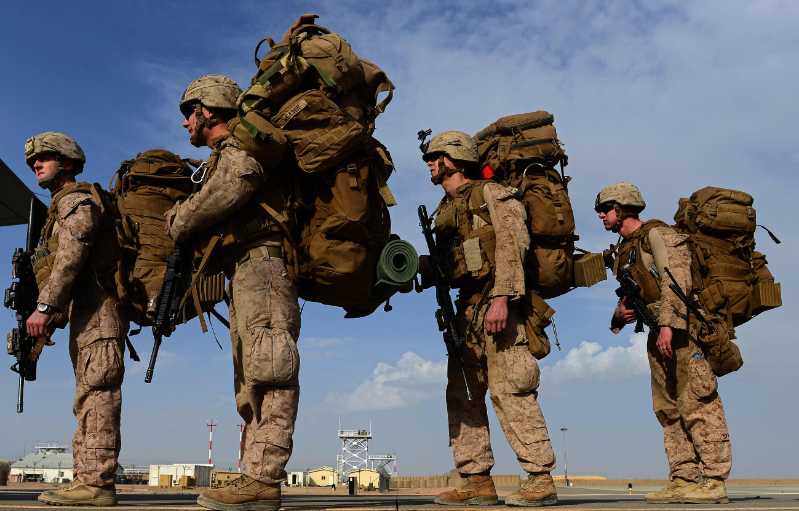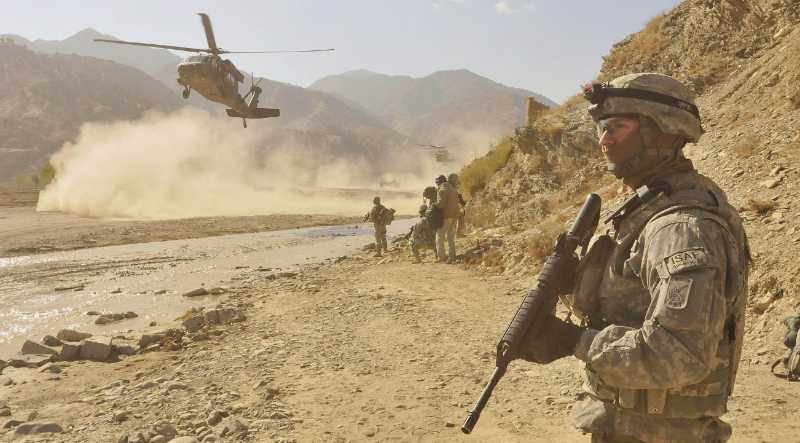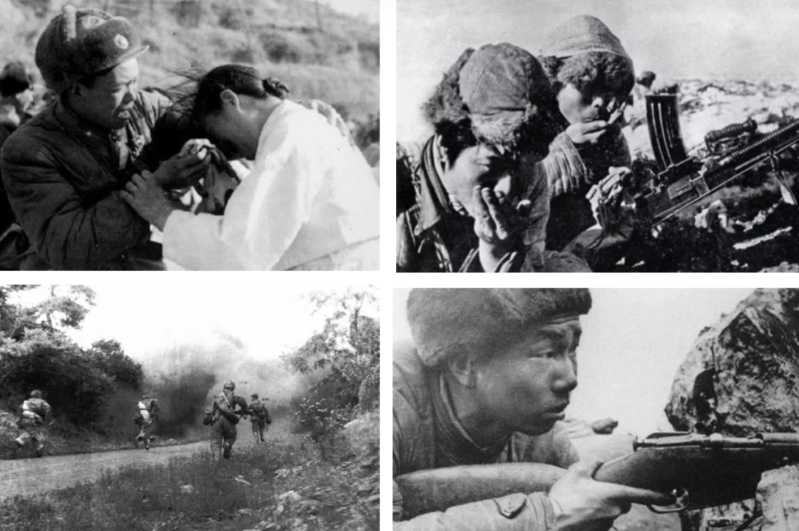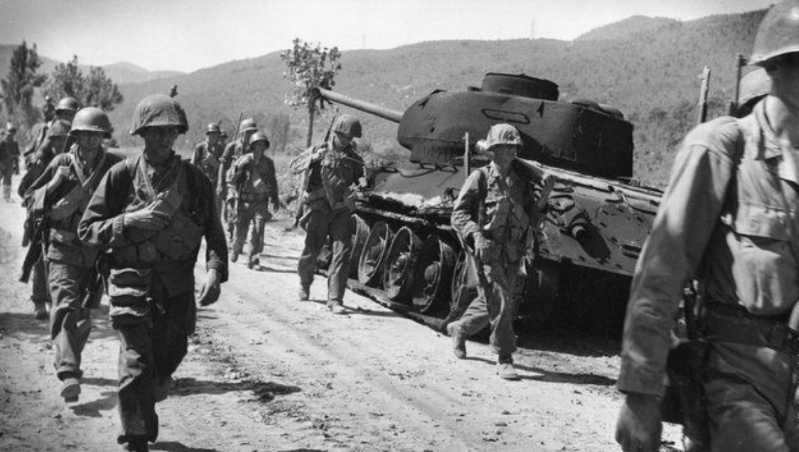During World War II, the German army was equipped with a variety of half-track vehicles, and the smallest of them was a special vehicle called a "tracked motorcycle". This small half-track vehicle is small, but it is a small and versatile all-terrain vehicle.
Unique
This is a strange-looking but widely used combat vehicle. Its front half looks like a motorcycle, equipped with a front wheel, handlebars and headlights with wartime luminous covers, but its rear half is a standard tracked vehicle. To the outside world, it may be a weird motorcycle, with a tactical positioning similar to those two-wheeled or three-wheeled motorcycles widely used in German reconnaissance units, but it may also be a tracked vehicle with similar functions to those larger half-track vehicles.
This is the smallest half-track vehicle equipped and used by the German army during World War II. The vehicle standard number is Sd.Kfz.2, and the official German name is Kettenkrad, which means "tracked motorcycle". This small half-track vehicle is positioned as a light traction vehicle for transporting supplies, towing trailers and light artillery. In the late war, the "tracked motorcycle" even had an amazing record of towing the Messerschmitt Me262 jet fighter.
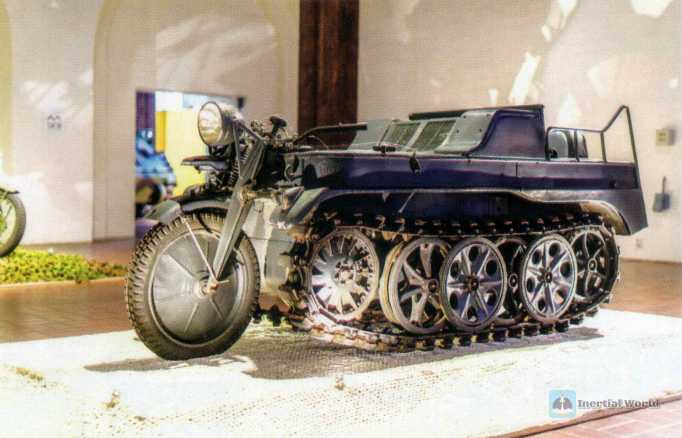
Kettenkrad began to be equipped with German ground forces in 1942, just in time for the hard fighting in the second year of the Soviet-German battlefield. In the autumn of 1941, BMW two-wheeled motorcycles and sidecar motorcycles, which were once one of the iconic equipment of the German army in the early days of the war, began to be replaced by amphibious jeeps (Schwimmwagen) with better versatility, and the emergence of the "tracked motorcycle" was another step in the same direction, especially in terms of towing capacity.
It turns out that in the muddy, wet or cold environment of the Eastern Front, the "tracked motorcycle" is almost unparalleled in traction and durability.
The Eastern Front was certainly not the only stage for this small half-track vehicle. This vehicle appeared on almost all the fronts where the German army participated in the middle and late stages of World War II: from the snow-covered plains of Ukraine, to the hot sands of the North African desert, to the rugged hills of Italy and Yugoslavia, and Normandy covered with bushes.
This German half-track vehicle was very popular, and the welcome was not limited to the German army. In the North African battlefield, the British 8th Army used the captured Kettenkrad very early and nicknamed it "Klad". In the Battle of France in 1944, the American soldiers there also liked the captured "Klad" and felt that it was more useful than their own jeeps.
The Sd.Kfz.2 "tracked motorcycle" is indeed one of the most unusual military vehicles in World War II, and there is almost no similar thing in the same era. The closest vehicle to it might be the Bren machine gun carrier or the Carloyd tank used by the British Army, but both of these vehicles are standard full-track vehicles.
In the German army’s equipment system, perhaps the popular amphibious jeep designed by Dr. Ferdinand Porsche is the only real competitor to the "tracked motorcycle". The amphibious jeep with a propeller at the rear and a boat-shaped lower body can move on the water and is widely loved by German and Allied officers. However, the material transportation and traction capabilities of this amphibious vehicle are obviously inferior to those of the Kettenkrad.

Strange inventions
The inventor of the Kettenkrad is the German engineer Heinrich Knepkamp. This man is an interesting and important figure in the field of German tracked vehicle design. Throughout the 1920s and 1930s, he was committed to the development of new tracked vehicles. After the outbreak of the war, Kniepkamp joined the Sixth Department of the German Army Ordnance Bureau, where he focused on the development of new tanks. He was involved in whimsical super-heavy tank projects such as the "Mouse" and E100.


In 1938, Kniepkamp proposed the idea of developing a very small half-track motorcycle that could be used for civilian and military purposes, such as helping lumberjacks haul logs. At that time, the concept of half-track vehicles was already popular in Germany, and Kniepkamp intended to combine the practicality of tracked vehicles with the flexibility of motorcycles. Kneipkamp sold his design to NSU, a motorcycle manufacturer in Neckarsulm, which quickly built a prototype and named the new vehicle HK101 after Kneipkamp’s initials. The standard configuration at the time was one driver and two passengers. However, the HK101 hit a wall in the commercial market. Many people felt that this small half-track vehicle was useless and could not show its mobility and carrying potential on forest trails. However, this vehicle attracted the attention of the German Wehrmacht after the outbreak of World War II in 1939. After studying it, the German Army ordered 70 HK101s for various tests at the end of that year.
The HK101 used for testing included motorcycle parts such as instruments, headlights, wheels, front forks and handlebar assemblies. With the motorcycle’s front fork, this half-track vehicle can achieve flexible steering functions on various paved and off-road roads. However, military tests showed that the standard motorcycle front fork was not hard enough for the HK101, and it often broke when the vehicle crossed ditches and ruts. Therefore, NSU adopted a more robust front fork to meet the needs of the half-track vehicle.
Although the new front fork did not perform well, the German military officially placed an order for the first batch of 500 vehicles to NSU in the second year
, and gave it the standard model name Sd.Kfz.2. Thus, Knepkamp’s unique design became a reality, and the German army did not care whether this vehicle was a motorcycle or a tracked vehicle. Technically, it was a traction vehicle.
Performance data
In the authoritative book "Historical Military Vehicle Guide", the performance data of the German "tracked motorcycle" was described as follows: "Tractor, half-track, small, Sd.Kfz.2, NSU HK-101. Four-cylinder 36 horsepower engine (Opel-Olympia), displacement 1478cc, fuel tank capacity 42 liters. Drive the front sprocket through a three-speed gearbox and a two-speed auxiliary box. Mechanical brakes (controllable differential). The bogie wheels have a torsion bar suspension. Track width 170 mm. Overall dimensions 3000x1000x1200 mm. Vehicle weight 1280 kg. Engine behind the driver. Production 8345 units, produced by NSU and Stowey between 1940 and 1944. Often towed a small trailer in use. ”
The driver sits on a sprung seat in the open cab at the front of the half-track, in a bathtub-like position that surrounds his lower body. The driver operates the dials, accelerator pedal, clutch pedal, brake pedal and steering handle.
The Kettenkrad has two steering modes, one on its single front wheel and the other on its two tracks. For small turns or high-speed steering, steering is done entirely by the single front wheel, while the track brake system takes over if the handlebars are turned more than 5 degrees.
The "tracked motorcycle" combines the features of a motorcycle with those of a tracked vehicle, making it one of the most capable vehicles on rough terrain. 1. It is said that Kettenkrad is not only unstoppable on flat and open land, but also has strong climbing ability. The upper limit of its climbing depends on the skills and courage of the driver, because if it is not careful enough when turning on the slope, it is easy to roll over. In fact, the center of gravity of Kettenkrad is relatively high, and the track is relatively narrow. This kind of vehicle is also prone to rollover when turning on flat ground. Drivers must operate this vehicle carefully.
There are many photos of Kettenkrad showing the climbing ability of this half-track vehicle. According to the records of the German army, the upper limit of the climbing of the "tracked motorcycle" is 45 degrees. In addition, it can travel in water no more than half a meter deep. On regular paved roads, the maximum speed of this half-track vehicle is The 36-horsepower Opel engine was transplanted directly from the NSU Olympia passenger car. It was originally a transitional solution, but the designers found that this engine was enough to drive the "Gu belt motorcycle" weighing less than 1.3 tons. And the fuel consumption of this engine is very low, so only two 21-liter fuel tanks are needed for the Kettenkrad.
The 36-horsepower Opel engine was transplanted directly from the NSU Olympia passenger vehicle. It was originally just a transitional solution, but the designers found that this engine was enough to drive the "Gu belt motorcycle" weighing less than 1.3 tons. And the fuel consumption of this engine is very low, so only two 21-liter fuel tanks are needed for the Kettenkrad.
Although the manufacturing cost of the engine is relatively low, the manufacturing cost of the gearbox is quite high, which is also one of the most technical components of the Kettenkrad. This gearbox has three forward gears and one reverse gear for both road and off-road, and the overall performance is is relatively stable.
The "tracked motorcycle" has a ground pressure of about 3.75 kg/cm2 on hard ground, and only 610 g/cm2 on softer ground. The two tracks of the vehicle each have 40 track shoes with replaceable rubber parts, and in the snowy environment of the Eastern Front, anti-skid spikes can be installed. The most expensive part of the movement device is the ball bearing of the connecting rod, because it has very high technical requirements.
Technical defects
The Kettenkrad is famous for its mechanical complexity, but in fact it does not have any particularly revolutionary or advanced technology. In terms of the actual situation of this vehicle, it may be more accurate to describe it as "unreasonably complex".
In the early vehicles delivered for use, there were constant troubles with the front fork. At the end of 1942 and the beginning of 1943, the German 6th Army, which was surrounded by the Red Army in Stalingrad, had many "tracked motorcycles". According to the feedback from this unit, the inherent fragility of the front fork really made users and mechanics complain.
After that, NSU adjusted the design and replaced the front fork of the "tracked motorcycle" with a steering device with a hydraulic shock absorber. However, the trouble that followed was that this steering device was always in a state where it could not be completely sealed, which caused the steering brake of Kettenkrad to waste oil.

Usually, just a few months after a new vehicle is delivered from the factory to the front line, the steering system will have different degrees of failure. After several revisions failed to solve the problem satisfactorily, engineers simply installed small drains near the steering brakes, which was tantamount to openly admitting that the half-track had a headache with oil leaks.
In fact, the main problem was that the hydraulic steering system was too complicated for a small vehicle like the Kettenkrad. As long as one component failed, it would trigger a chain reaction, and then more and more other components would fail. Some technical experts believed that this was caused by the lack of high-quality parts during the war, and they pointed out that if better quality parts could be used, the probability of similar problems would be much smaller.
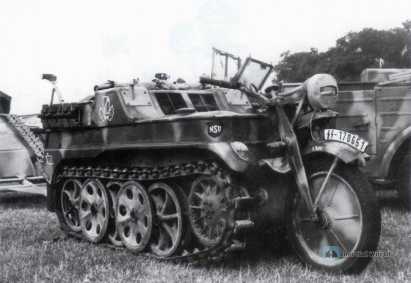
Another problem was the reverse gear in the gearbox, which was found to have the same problem as the front fork, that is, it was not strong enough. Under excessive pressure, the reverse gear would be damaged, which would then cause the aluminum gearbox housing to crack, thereby damaging more parts. Some technicians pointed out that the track structure of Kettenkrad was too complicated and difficult to maintain and replace. NSU engineers admitted that these tracks were more complicated than traditional tracks, but if properly maintained, their service life would be longer than ordinary tracks. However, the problem of the German army in the middle and late stages of the war was the lack of logistical support. Vehicles like "tracked motorcycles" could not be carefully maintained, so the designer’s clever idea became a burden on the front-line troops.
Important role
The "tracked motorcycle" first appeared on the battlefield in July 1942, but it was not until the winter of that year that this half-track vehicle began to be equipped on a large scale by various German troops. In the North African battlefield, which was very different from the extremely cold battlefield conditions on the Eastern Front, Kettenkrad played an important role in the German African Corps of Field Marshal Erwin Rommel. After the German army failed in the Battle of El Alamein, a paratrooper unit led by Major General Hermann Ramcke successfully escaped the encirclement of the Allies while separating from the main force of the African Corps. The "tracked motorcycle" played a big role in it.
In the spring of 1943, during the battles around Tunisia, the last bastion of the Axis Powers in North Africa, German mechanics welded additional water tanks on the sides of the Kettenkrad and equipped it with a multi-speed fan/ventilator to better cool the engine under the scorching sun. After the German army retreated to Italy, this half-track vehicle played an important role in the German Air Force’s "Hermann Goering" Armored Division, which fought in Sicily and Italy.

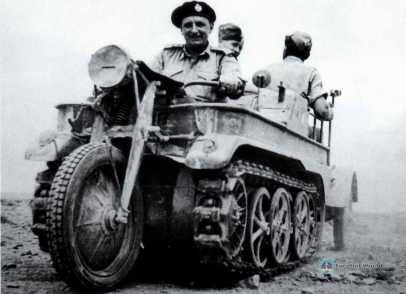
In the second half of 1943, the German army released the latest half-track motorcycle reconnaissance company, which completely replaced the previous motorcycle reconnaissance company. As the name suggests, the newly organized reconnaissance company is equipped with a large number of half-track vehicles, and Kettenkrad is the main model. According to the organizational specifications, a half-track motorcycle reconnaissance company has 3 officers, 35 non-commissioned officers and 189 soldiers. The vehicle equipment includes 6 passenger cars, 9 heavy half-track tractors, 11 single-axle trailers, 7 light motorcycles and 61 "tracked motorcycles", also known as Kettenkrad.
During this period, Kettenkrad also proved to be a powerful tool for laying telephone cables on the battlefield, and NSU also built two special models of "tracked motorcycles" Sd.Kfz.2/1 and Sd.Kfz.2/2. The former is used to lay standard field communication cables, while the latter is suitable for heavier cables.
The "tracked motorcycle" also appeared in several other derivative models during the war. One of them is equipped with a power-upgraded Opel engine, which is mainly used for troop transportation. The other type is a widened explosive transport vehicle. More than 50 vehicles of this type were manufactured, but due to the Allied bombing, the transportation lines could not be delivered, and only 3 vehicles were put into use. In addition, NSU also launched an amphibious version of Kettenkrad, but the test response was not as good as the amphibious jeep widely used in the German army.
By the end of the war, the production of Kettenkrad was fixed at 8,345 vehicles. However, based on its extensive civilian characteristics, the Allies allowed German factories to reopen the production line of this half-track vehicle after the war. Its mass production continued until 1949, which brought its total production to about 9,500 vehicles. In the devastated German land after the war, the "military-to-civilian" "tracked motorcycles" were mainly used by wine growers, farmers and West German forestry officials.
Today, the Kettenkrad, which is quite rare in existence, is a favorite of military collectors. Some of the collections have been carefully restored and maintained, and appear from time to time at military exhibitions, museum activities and military enthusiasts gatherings around the world.


